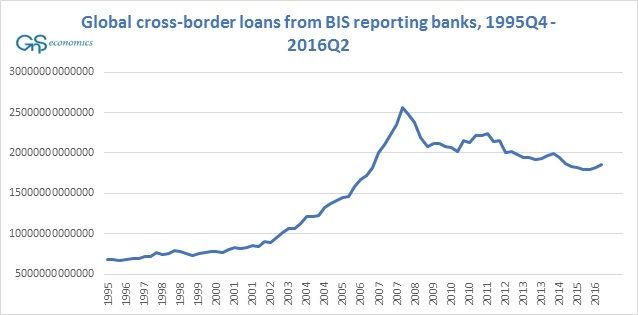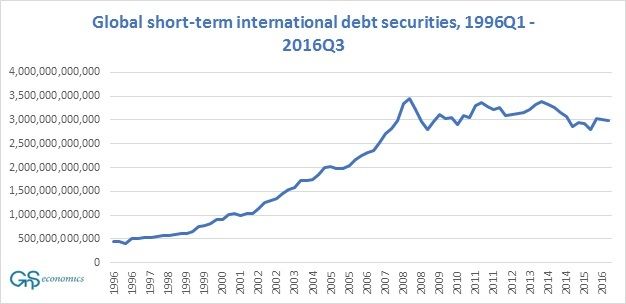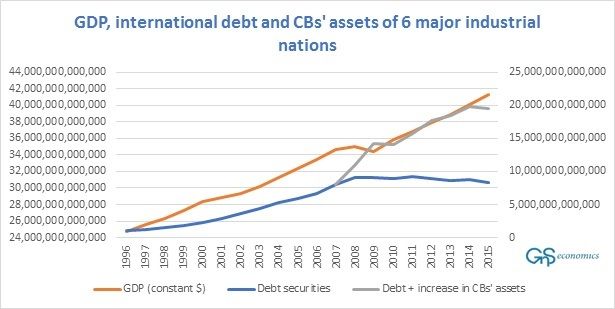World economy has seen an uneven and sluggish recovery from the financial crash. While the average annual GDP per capita growth was 2.3 % from 1994 to 2008 (1991-1993 there was a global recession), this growth was only 1.5 % from 2010 to 2015.
In this entry, I will argue, based on a report by GnS Economics, that the reversal or stagnation of financial globalization has been a major but neglected factor behind the sluggish recovery of the world economy from the crisis. Central banks have responded to this by creating massive amounts of artificial liquidity, which have raised the prices of assets to unsustainable levels. When the next recession begins, which may be closer than many of us think, the asset bubble will burst and the global economy will crash.
Reversal trend in financial globalization
For recent decades, globalization has been the driving force of economic growth. Moving production to low-cost countries tamed inflation, elevated millions of people out of poverty and fostered global growth. In this process, financial globalization has played an essential role, as it has been seeking the most productive investments worldwide. This has been visible in growing cross-border bank lending and in the increased issuance of international debt securities. However, the cross-border bank lending started to contract already in 2008 (Figure 1) and the growth in the international debt securities stopped in 2008 (Figure 2).


The plausible explanations for the declining international debt issuance include:
1. Geopolitical tensions are increasing.
2. Debt securities and cross-border lending are returning to their long-run/natural trend from the debt-fueled boom in the late 1990’s and early 2000’s.
3. The world economy has been in a slowly moving crash since 2008, which can pick up pace at any moment.
4. Combinations of the above.
Every explanation spell troubles for the global asset markets and GDP growth.
The central banks and the “recovery”
Because debt and especially bank lending creates liquidity, stalling or diminishing the loan creation indicates that there is less liquidity in the world economy, which leads to global deflation and recession. The major central banks have been battling this trend since the crisis of 2007 - 2008 (Figure 3). They have tripled the size of their balance sheets (from around $6 trillion to around $18 trillion) through the programs of quantitative easing (QE) to stem off the global deflation. Governments have joined the battle and the share of central government debt to GDP in 36 major industrial economies rose from 62.5 % in 2008 to 83.4 % in 2015. The global sovereign debt is now standing at $44 trillion (around 60% of global GDP). These measures have been able to create only a feeble recovery at the expense of financial stability.

When the central banks take active roles in financial markets, as they have done, they mess up the price signals. This is because central banks, unlike normal investors, do not need to obey the fundamental economic principle of scarcity. That is, they have no budget limit. The larger the role of the central banks in the financial markets, the larger disruption in the price signals and in the allocation of capital.
Because central banks have bought massive amounts of government and corporate bonds, the current levels of valuations in the asset markets are sustained only through central bank-induced artificial liquidity. Central banks have actually painted themselves into the corner. Returning to normally functioning market economy would require that the interest rates would be normalized and the cbs’ would sell their holdings of the corporate and government bonds. These would crash the asset markets. The central banks cannot go on buying debt securities indefinitely either, as this would kill the capital markets.
Thus, the central banks face a perplexing problem. As they hold large amounts of government and corporate debts, a dramatic fall in their values could force the central banks to bear heavy losses thus impairing their independence and credibility. Although the central banks can temporarily operate with negative capital, losses would eventually need to be covered. This can be done either through capital injections from the governments and/or by increasing seigniorage revenues through money printing. As the governments are already highly indebted, money printing is the only option. But this tends to lead to rapid deterioration in the value of money, i.e., to markedly fast inflation.
There is a crash in the horizon
The artificial liquidity has created a massive asset bubble that has just come too big to avoid a massive correction. Without some kind of “divine intervention”, the bubble will burst and the world economy will crash.
For the crisis to start, all that is required is a trigger that starts a panic selling in the financial markets. Faced by a market panic, the central banks would probably re-start or hasten their QE-programs and/or resort even more desperate means, like helicopter drops of money. It is uncertain whether these would be enough to stem the panic, but even if successful, they could just delay the onset of the crisis. The ability of the central banks to act in a full blown crash is also questionable, as losses they would incur would jeopardize their independence.
The timing of a market crash, however, is notoriously difficult to predict. This is, because “markets can remain irrational longer than you can remain solvent”, and this applies especially now when the central banks and government officials are on the driver’s seat. The crash, however, is not a question of if, but when, and the “when” may be just around the corner.
